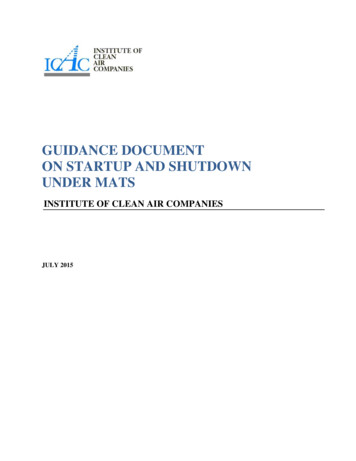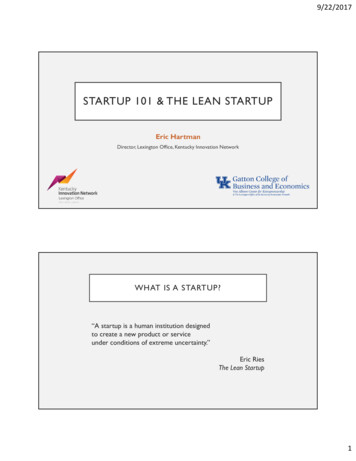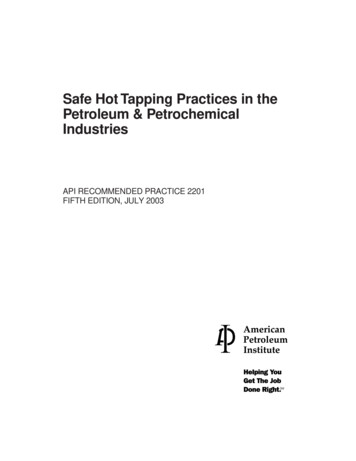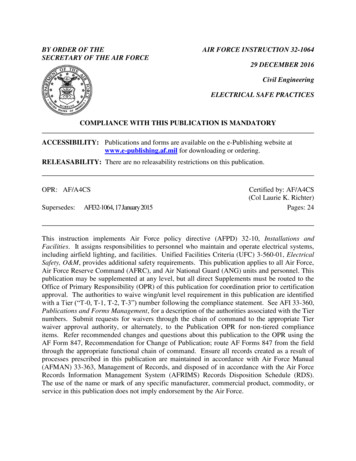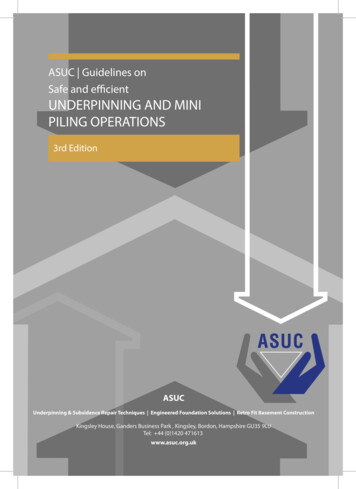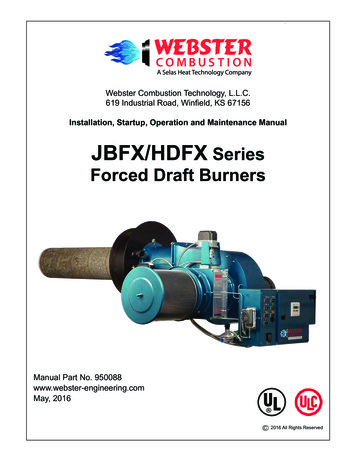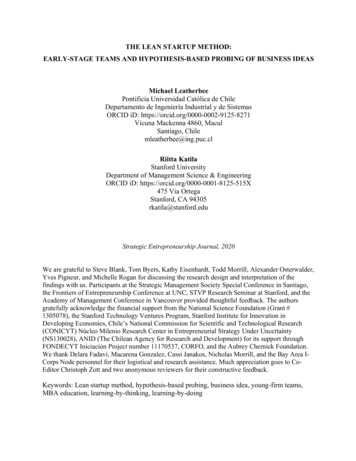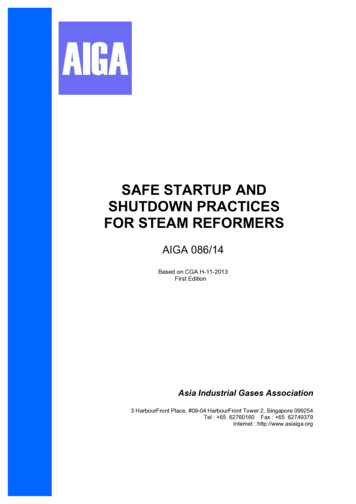
Transcription
SAFE STARTUP ANDSHUTDOWN PRACTICESFOR STEAM REFORMERSAIGA 086/14Based on CGA H-11-2013First EditionAsia Industrial Gases Association3 HarbourFront Place, #09-04 HarbourFront Tower 2, Singapore 099254Tel : 65 62760160 Fax : 65 62749379Internet : http://www.asiaiga.org
AIGA 086/14SAFE STARTUP ANDSHUTDOWN PRACTICESFOR STEAM REFORMERSDisclaimerAll publications of AIGA or bearing AIGA’s name contain information, including Codes of Practice, safety procedures and othertechnical information that were obtained from sources believed by AIGA to be reliable and/ or based on technical information andexperience currently available from members of AIGA and others at the date of the publication. As such, we do not make any representation or warranty nor accept any liability as to the accuracy, completeness or correctness of the information contained in thesepublications.While AIGA recommends that its members refer to or use its publications, such reference to or use thereof by its members or thirdparties is purely voluntary and not binding.AIGA or its members make no guarantee of the results and assume no liability or responsibility in connection with the reference to oruse of information or suggestions contained in AIGA’s publications.AIGA has no control whatsoever as regards, performance or non performance, misinterpretation, proper or improper use of anyinformation or suggestions contained in AIGA’s publications by any person or entity (including AIGA members) and AIGA expresslydisclaims any liability in connection thereto.AIGA’s publications are subject to periodic review and users are cautioned to obtain the latest edition.Reproduced with permission from Compressed Gas Association. All rights reserved.ASIA INDUSTRIAL GASES ASSOCIATION3 HarbourFront Place #09-04 HarbourFront Tower 2 Singapore 099254Internet: http://www.asiaiga.org
AIGA 086/14PAGE iiiContentsPage1Introduction and purpose. 11.1Introduction . 11.2Purpose . 12Scope . 23Definitions. 24General considerations . 54.1Personnel safety . 54.2Emergency response . 64.3Process safety . 64.4Communication . 64.5Recommended operating procedures . 64.6Materials and Equipment . 74.7On-line furnace inspections . 75Startup . 85.1Pre-startup preparation . 85.2Nitrogen flow and reformer ignition . 95.3Steam generation and introduction . 115.4Feed introduction considerations . 125.5Establishment of downstream units . 135.6Introduction of additional fuel streams . 145.7Plant restart after trip . 146Shutdown . 156.1General shutdown preparation . 156.2Controlled shutdown procedures (planned shutdown) . 156.3Unplanned shutdown . 176.4Isolation and purging of flammable gas systems in preparation for maintenance. 187Training and procedures . 188References . 19
AIGA 086/1411.1PAGE 1Introduction and purposeIntroductionAs a part of a programme of harmonization of industry standards, the Asia Industrial Gases Association (AIGA)has adopted the Compressed Gas Association (CGA) standard H-11.This international harmonized document is intended for use and application by all IHC member associations.The AIGA edition has the same technical content as the CGA edition, however, there are editorial changesprimarily in formatting, units used and spelling. Also, references to regional regulatory requirements have replaced US regulations where appropriate.Large scale hydrogen production has been commercially practiced for decades and the demand for such production has grown over that period. In the last several years, developments in crude oil processing, such as theincreased use of hydrogen to remove sulfur and the refinement of heavier crude oil stocks, has driven significant growth in the demand for hydrogen supply.In response to this demand, industrial gas companies operate and maintain large scale hydrogen productionfacilities worldwide and have done so with an exemplary safety record for many years. However, it should benoted that large scale hydrogen production involves potential personnel and process safety hazards that mustbe addressed in design and operation. Such hazard potential is inherent to the processing of toxic and flammable gases via high temperature reforming as practiced in hydrogen production.The steam reformer represents the core operating unit of most large scale hydrogen production facilities.Therefore, steam reformer furnace combustion safety is fundamental to the overall safe operation of theselarge scale hydrogen plants. The startup and shutdown of the reformer can create transitional periods of increased risk to the operation of the facility. The operating procedures and practices employed during startupand shutdown must effectively address the potential hazards of such transitions to ensure plant safety.The need to specifically consider and address the startup and shutdown of industrial processes is well recognized as a cornerstone to safe operation. Requirements to ensure startup and shutdown safety are addressedin operating procedures and are included in process safety regulations in Title 29 of the U.S. Code of FederalRegulations (29 CFR) Part 1910.119, Process safety management of highly hazardous chemicals, referred toas OSHA Process Safety Management (PSM), and in Europe, Directive 96/82/EC on the control of majoraccident hazards (known as the Seveso II Directive), among other regulatory bodies [1, 2].Guidelines for the safe startup and shutdown of industrial production units are technology specific. Industrywide publications addressing startup and shutdown practices exist for many technologies, including industrypublications such as AIGA 056/08, Safe Practices Guide for Cryogenic Air Separation Plants, which addressesstartup and shutdown of air separation plants [3]. At this time, no such industry-wide guidelines have beencompiled and published for steam reformer operation.It should be noted that there are other industries, such as ammonia and methanol production, that operatelarge steam reformers. Therefore, it may be instructive to consider the learning and experiences from thoseindustries through organizations such as the American Institute of Chemical Engineering: Ammonia Plant Safety Symposium and the International Methanol Producers and Consumers Association (IMPCA).Steam reformer furnace design will continue to develop along with methods to implement combustion safety inthese furnaces. A wide variety of steam reformer designs, configurations, and component equipment existstoday. Therefore, this publication includes generalized statements and recommendations on matters whichthere may be diversity of opinion or practice. Users of this publication should recognize that it is presented withthe understanding that it can supplement, but not take the place of, sound engineering judgment, training, andexperience. It does not constitute, and should not be construed to be, a code or rules or regulations.1.2PurposeThe purpose of this publication is to inform and guide interested parties on the procedures and practices fundamental to combustion safety in the operation of steam reformers. This publication presents a baseline forsafe reformer operation which, if followed, assures our customers that the hydrogen they receive from member
PAGE 2AIGA 086/14companies has been produced according to accepted industry-wide safety guidelines. This publication providesa technical basis that can be used to present a common viewpoint to government and regulatory authorities,ensuring proper application of rules and regulations.2ScopeThis publication applies to steam reformers that are operated with natural gas, refinery off gas, naphtha, andother light hydrocarbon streams. It specifically applies to large volume hydrogen production plants, defined forthis publication as a production capacity of 380 000 scfh (10 000 Nm3h) (9 MMSCFD or 240 000 Nm3D) orgreater. This publication may be applied to smaller reformers depending on the technology used.This publication covers operational safety of steam reformer startup and shutdown. Emphasis is placed on operational guidance and features that provide safeguards against the hazards associated with the transition andinfrequent nature of startups and shutdowns. The publication is not intended to address the details of design,installation, construction, and initial startup (commissioning) of steam reformers.3DefinitionsFor the purpose of this publication, the following definitions apply.3.13.1.1Publication terminologyShallIndicates that the procedure is mandatory. It is used wherever the criterion for conformance to specific recommendations allows no deviation.3.1.2ShouldIndicates that a procedure is recommended.3.1.3MayIndicates that the procedure is optional.3.1.4CanIndicates a possibility or ability.3.2BoilerClosed vessel in which water is heated and steam is generated by heat input from combustible fuels in a selfcontained or attached furnace.3.3BurnerDevice for the introduction of fuel and air into a combustion chamber at the velocity, turbulence, and concentration required to maintain ignition and combustion of fuel.3.4Burner management system (BMS)Control system dedicated to combustion safety and operator assistance in the starting and stopping of fuelpreparation and combustion equipment and for preventing improper operation of and damage to fuel preparation and burning equipment.3.5BypassMeans used to temporarily deactivate an alarm, control, or protection system including, but not limited to:jumper wires, control system overrides, forced values, modified set-points, modification of the normal lock openor closed valve positions, taking the device off-line, or running temporary hoses. Based on the type of bypass,it can also be referred to as an override, shunt, or jumper.3.6Bypass logFormal document used to track the approval, installation, management, and removal of bypasses.
AIGA 086/143.7PAGE 3Cold collectorRefractory lined piping system wherein the exit of the catalyst tubes are directly connected to a refractory linedpiping manifold.3.8Combustion airAir used to react with the fuel in the combustion process.3.9Convection sectionPortion of the reformer, downstream of the furnace, where flue gas passes over heat exchangers and heattransfer occurs via radiation and convection.3.10DamperValve or plate for controlling draft or the flow of gases, including air.3.11Dead legSection of a piping system that normally has no significant flow (one end blocked or restricted) with a lengthgreater than 3 to 6 pipe diameters.3.12Double block and bleed (DB&B)Piping or instrument arrangement that combines two block (or isolation) valves in series with a vent valve inbetween the block valves as a means of releasi
installation, construction, and initial startup (commissioning) of steam reformers. 3 Definitions For the purpose of this publication, the following definitions apply. 3.1 Publication terminology 3.1.1 Shall Indicates that the procedure is mandatory. It is used wherever the criterion for conformance to specific recom-mendations allows no deviation.File Size: 237KBPage Count: 22
